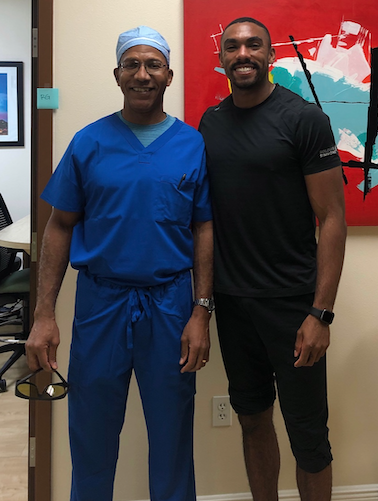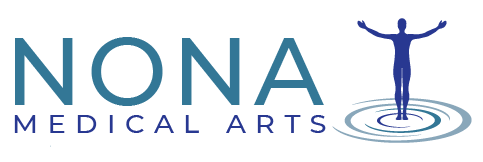This time last year, Solomon Simmons was running out of options. The 6’4” professional decathlete, ranked #2 in the nation, had been struggling with a lingering hamstring injury for the last 8 months.
Now, it was getting worse, threatening to put an early end to his season.
Solomon had exhausted the usual therapies; rehab, ice, massage, compression, pain relievers. Local doctors in Atlanta had recommended he take 6-8 weeks off at the minimum. If he didn’t, they warned, the injury would likely end his season for good. He decided to try one more local doctor, just for luck. When that doctor suggested surgical intervention, a surefire nail in his season’s coffin, Solomon knew it was time to look for alternative injury treatments.
He remembered that his first cousin once removed, Dr. Richard Gayles, runs comprehensive pain management practices in Orlando and Merritt Island, Florida. Dr. Gayles is a top interventional pain specialist and a pioneer in something called “regenerative medicine,” which focuses on harnessing the body’s natural capacity for self-healing. What does that mean? Typically, regenerative treatments involve using growth factors, stem cells, and naturally occurring nutrients from the patient’s body to heal the affected area. These procedures can offer a critical alternative when invasive procedures aren’t possible– and for Solomon, who was shooting for the #1 decathlon mark in the US that year, anything invasive was off the table.
Dr. Gayles typically focuses on joint pain relief in older individuals, but he’s seen promising results in athletes as well. He told Solomon he’d be a great candidate for regenerative therapy, so Solomon hopped on a plane and flew from Atlanta to Florida in a last ditch effort to tackle his hamstring injury and save his track season.
There are many different types of regenerative therapy, but Dr. Gayles decided to give Solomon a stem cell injection containing platelet rich plasma (PRP) and Exosomes for its simplicity and efficacy. PRP is a solution of concentrated platelets taken from the patient’s blood, while exosomes are “messenger vesicles” derived from young, healthy stem cells. In the body, Exosomes transfer information between cells.
Here’s the idea behind Dr. Gayles’ injection: when older, damaged cells come in contact with exosomes, the exosomes transfer information from their young, healthy parent cells to the older cells, stimulating rejuvenation. The PRP serves as a kind of booster, adding high concentrations of growth factors and cytokines that help speed up the healing process and provide pain relief.
The procedure itself was quick, says Solomon, no more than 45 minutes. His uncle drew some blood, spun it in the centrifuge to create the PRP, added exosomes to the mix, and injected the solution into the belly of Solomon’s hamstring. The pain was minimal, maybe a 3 at most. The hamstring was sore for an hour after the procedure and remained a little sore the next morning, but over the week, it faded away.
Dr. Gayles recommended Solomon rest for a week after the procedure, so he did. The following week, Solomon worked back up to his typical training level, and to his surprise, he could barely feel the injury. “I was shocked,” he says. “Seriously shocked.” Yes, he’d trusted Dr. Gayles, but he hadn’t expected such astronomical improvement in such a short period of time.

On week three, Solomon travelled to Texas for a decathlon competition. He was feeling good, great actually, but he was still nervous about the 100-meter dash, a test of pure explosiveness that puts a strain on even healthy hamstrings. When he made in through the race without a problem, he knew the rest of the meet would be a cinch. Solomon left Texas as the #1 decathlete in the nation, and hasn’t had a hamstring issue since.
“I don’t want to call anything a magic bullet,” says Solomon, “But for me, this treatment was. I think it’s safe to say if I ever have another injury in my athletic career — or my life — I’ll first consult my cousin to see if regenerative therapy can solve the problem.”

